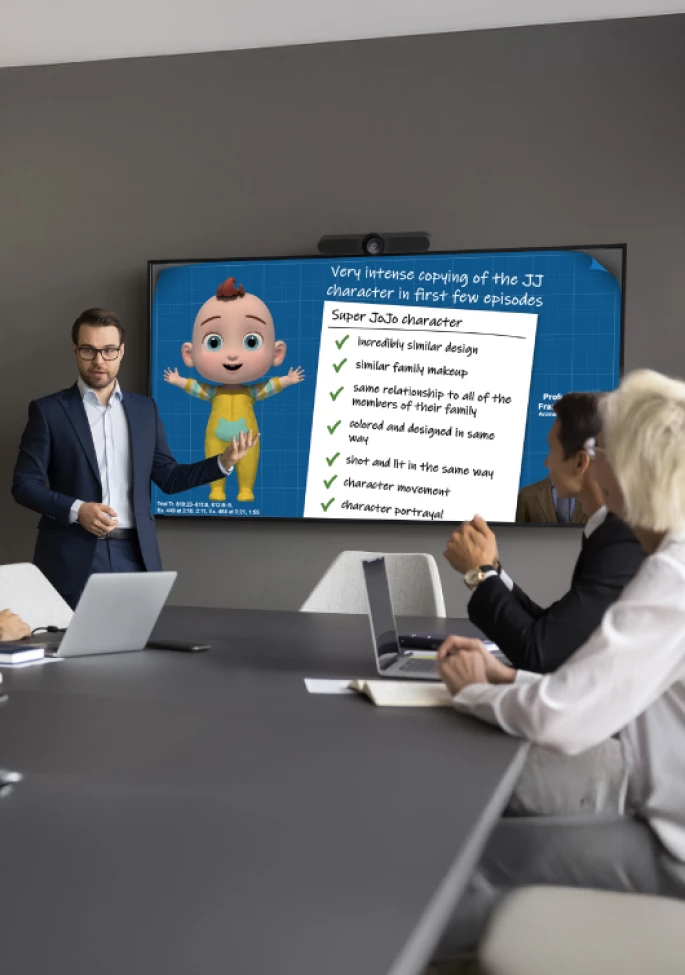Visual presentations have become the most effective communication tools for explaining complex stories to audiences. The heavy use of social media platforms has wired some modern viewers to become visual learners. When these individuals are seated in the jury box, information presented in simple pictorial forms can lead them to achieve high levels of understanding and retention of case information.
Crucial courtroom decisions have resulted from visual presentations that effectively nudged jurors from one party’s side to the other. By using simple graphic stories to enhance your arguments, you will increase the chances of persuading visual learners to take your client’s side in a case.
Below are nine tips to consider when putting together a presentation for today’s visually plugged-in jurors:
How to Create an Impactful Visual Presentation for Trial
1) Keep It Simple
Break the narrative down to basics. All stories—no matter how complex—should have a simple thread introducing major players to set the scene. Setting the scene will help lay the foundation for your case story’s chapters.
2) Make It a Good One
Most people appreciate good storytelling, but a compelling story gets more attention, raises retention factors, and builds viewer trust. The facts, organized into relatable chapters, can pull the main points of your case into relevant scenarios for the jury. Presenting stories that have familiar themes may also help jurors form solid cognitive connections.
3) Sketch Out Ideas
We can all sketch ideas onto paper. The game Pictionary, during which players decipher others’ drawings, is a perfect example. While playing Pictionary, I have witnessed teammates successfully convey messages by drawing basic sketches—often those as simple as stick figures and geometric shapes. Similarly, your vision for a courtroom presentation can be prepared by drawing stick figures and geometric shapes. These rudimentary sketches will form the basis for images that will effectively convey your case messages.
4) Get to the Point
Here is the hard part. To ensure the jury will have a clear understanding of your messages, it is important to strip complex concepts down to basic shapes. Sketch all the relatable thoughts that pop into your head while you are reading story chapter outlines, even if you decide to only turn some of them into computerized graphics. The most effective visuals usually result from well-thought-out concept development sessions.
5) Set the Mood
Backgrounds, color schemes, images, and typeface decisions are major components for setting the tone of your courtroom messages. The combination of these elements can determine the mood of the entire presentation. Choose your design factors carefully since they can play an important role in how the jury will respond to your visual messages, and remember to stay consistent with the spectrum of creative choices throughout the entire presentation.
6) Go Back to Basics
A trial is not a place to use ornate graphics. Decorative elements may distract jurors from following visual roadmaps that are intended to guide them toward making a favorable decision. Your main objectives should be to successfully convey key themes, facts, and messages.
7) Think About Placement
Control the way the jurors gaze at certain aspects of your designs by carefully positioning display elements. The conscious placement of images can lead the jurors’ eyes along an invisible path from one element to the next. For example, a magazine layout with a large illustration positioned on the right side of the page will usually cause the jurors to focus on the graphic before looking at other elements. A good rule: the artwork that is the main focal point of each of your presentation displays should utilize the largest image or boldest color.
8) Determine Your Communication Strength
What type of presenter are you? Are you linear or nonlinear? If you are a linear presenter, you are probably comfortable with a PowerPoint presentation because it goes from one slide to the next without skipping slides. If you are nonlinear, you may want to go back to basics and use an overhead projector, large presentation boards, or a combination of both. Technology shouldn’t matter if you are able to get your point across and connect with the viewers. You may consider using someone to navigate a trial presentation program to pull up individual slides upon your cue. Most importantly, choose a presentation medium that makes you most comfortable.
9) Remember Less Is More
The average Gen-Xer and Gen-Yer— today’s jury pool majority— has grown up using the internet, and studies show that their attention spans are limited to short sound bites and quick snippets of information. A well-thought-out presentation that relays ideas simply and poignantly may just tip the scales of justice in your client’s favor and successfully convince a jury to view the story as you see it.
In Conclusion
In today’s world, your legal presentations must be tailored to visual learners. Incorporating strategic design in the courtroom is not only a productive way to convey your core themes, but it also helps jurors recall your evidence and advocate for your client in deliberations. Following the guidelines above and working with visual communication specialists are two effective methods for developing informative, memorable presentations that speak to modern jurors.
View this article on The National Law Review here: Utilizing Visual Presentation for Visual Learning Jurors (natlawreview.com)







